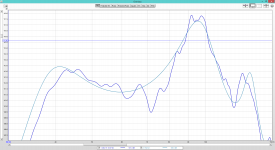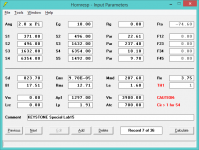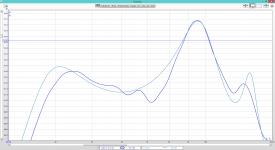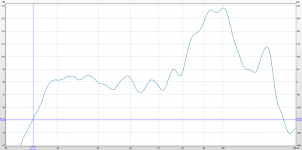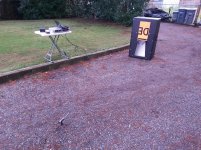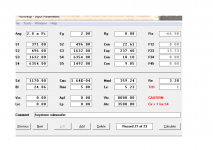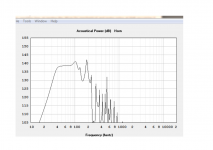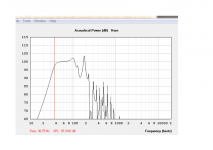You are comparing the wrong figures, the Crown's 1kHz output should be compared to the NU6000 maximum output of 3000W.
Even if you don't want to believe that, the difference between 2200 and 2400 watts would be inaudible (a fraction of a dB), assuming the XLS2502 current limiting sounds as transparent as the NU6000.
One side of the NU6000 can deliver more power than the bridged XLS2502. With two NU6000 you would have more than four times the power and save around $420 over a pair of XLS2502.
According to the big NU6000 test that everyone seems to reference, the NU6000 will do 1.8kW per side continuously into 4ohm at low frequencies, and 1.2kW/ch @8ohm.
I'd say an XLS2502 is basically an NU3000, so the NU6000 is roughly a pair of those bridged. I like the NU6000s, but wish the 4-channel version was available over here.
Chris
Sam,Question for the Nuke DSP users. Can you do BOTH a HPF AND LPF per channel or bridged? (dedicated TH amp without XO)
Yes you can.
You don't have to be a user to read the manual:
https://media.music-group.com/media/PLM/data/docs/P0AEO/NU6000DSP_NU3000DSP_NU1000DSP_M_EN.pdf
Attachments
Just finished up a Lab15-4 loaded keystone. Ran a lot of different sims and configurations for the driver. Even with hornresp predicting a response that's a bit lumpy, it was still a very competitive configuration especially with the extremely good cooling to wind it up past its thermal rating compared to FLH or bandpass setups.
I'll hopefully pull it outside to do measurements tomorrow. Sounds pretty good. I'll have to put together a caster board as well. Turns out it's not a pick-up-and-move box. The weight's not too bad but the size means there's no easy way to grab it.
Now I just have to start all over and make another. I think I'm going to omit the removable panel this time. turns out there's no issue installing the 15" driver through the aperture.
I think I'm going to omit the removable panel this time. turns out there's no issue installing the 15" driver through the aperture.



I'll hopefully pull it outside to do measurements tomorrow. Sounds pretty good. I'll have to put together a caster board as well. Turns out it's not a pick-up-and-move box. The weight's not too bad but the size means there's no easy way to grab it.
Now I just have to start all over and make another.
 I think I'm going to omit the removable panel this time. turns out there's no issue installing the 15" driver through the aperture.
I think I'm going to omit the removable panel this time. turns out there's no issue installing the 15" driver through the aperture.


Did a few sweeps outside at moderate power. Didn't calibrate the voltage but the mic is at 1m from the center of the aperture on the ground and should be SPL accurate.
Thank god for the UMIK-1 I just got. Infinitely easier than fiddling with XLR cables and preamps and whatnot.
I changed the voltage on the hornresp sim until I could get the sim and measurement to overlay. Pretty cool to see how close they correlate, especially considering the aperture isn't technically a feature that hornresp can simulate. Uploaded unsmoothed and 1/12 octave smoothed screenshots.
Looks like I'm going to use a bit of PEQ to squash the passband flatter, but hornresp already made that clear. The higher low corner is a slight disappointment, but I might just EQ it out to a bit below 40hz since that should be near excursion minimum.
Thank god for the UMIK-1 I just got. Infinitely easier than fiddling with XLR cables and preamps and whatnot.
I changed the voltage on the hornresp sim until I could get the sim and measurement to overlay. Pretty cool to see how close they correlate, especially considering the aperture isn't technically a feature that hornresp can simulate. Uploaded unsmoothed and 1/12 octave smoothed screenshots.
Looks like I'm going to use a bit of PEQ to squash the passband flatter, but hornresp already made that clear. The higher low corner is a slight disappointment, but I might just EQ it out to a bit below 40hz since that should be near excursion minimum.
Attachments
Last edited:
ZettairyouikiDid a few sweeps outside at moderate power. Didn't calibrate the voltage but the mic is at 1m from the center of the aperture on the ground and should be SPL accurate.
Pretty cool to see how close they correlate, especially considering the aperture isn't technically a feature that hornresp can simulate.
The higher low corner is a slight disappointment, but I might just EQ it out to a bit below 40hz since that should be near excursion minimum.
The exit size had to be reduced when testing a 15' (rather than an 18" or 2 x12") to reduce the upper peak and extend the bottom corner.
Try clamping on a board over the top of the Keystone exit and reduce a bit at a time, checking response as you reduce. There will be an "optimum" point between extended low corner and reduced output above.
Try measuring at two meters, one is a bit close for a cabinet this size, and the upper response is directed downward a bit, it may not "look as bad" a bit further away.
Art
Last edited:
No, it won't affect the response,(other than potential rattling) as long as the Keystone exit is sized as designed.Maybe a dumb question, but would a metal grill placed in the opening change anything? I know normally it is no big deal, but it seems that on this sub the size of the opening matters more than normal...
-Kelly
Art
Got set up to run more sweeps and adjust the aperture size. Quite a pain with the freezing temperatures outside. 23" looked the best to me. Drops the tuning a bit and fill in the ~60hz dip. Any smaller and the response gets lumpier again favoring the low end. Still got the 6db bump to PEQ out on the top, but once that's done it looks like it'll be nice and flat with a -3db point at almost exactly 35hz which I think will work great for the music I play.
So really that's only 2 inches off the top of the aperture. Doesn't seem like a whole lot to me but the response looks good. I did measure a bit farther away this time so that could account for some change as well.
So really that's only 2 inches off the top of the aperture. Doesn't seem like a whole lot to me but the response looks good. I did measure a bit farther away this time so that could account for some change as well.
Attachments
Never heard of the mach5 UXL, post up the sim response at Xmax and I'll tell you what I think.Hi Art,
What do you think o about using a mach5 UXL in the keystone?
From sims, it could make a lot of noise
Never heard of the mach5 UXL, post up the sim response at Xmax and I'll tell you what I think.
Hi Art,
The mach5 UXL-18 is a very robust driver also tested at Data-Bass and it has a very high X-max of around 34 mm.
The sim look ok and the max SPL at almost xmax is very high. the only thing is that the driver is very deep so it might not fit the keys. also, to reach xmax it needs around 7000 watts, so it will not get that SPL for longer than few cycles.
Attachments
Impressive (and way heavy) driver, response looks good on paper!Hi Art,
The mach5 UXL-18 is a very robust driver also tested at Data-Bass and it has a very high X-max of around 34 mm.
The sim look ok and the max SPL at almost xmax is very high. the only thing is that the driver is very deep so it might not fit the keys. also, to reach xmax it needs around 7000 watts, so it will not get that SPL for longer than few cycles.
Josh tested the Mach5 UXL-18 at 93 volts, about 2700 watts, so it should survive peaks about 3 dB less than the sim shows.
- Home
- Loudspeakers
- Subwoofers
- Keystone Sub Using 18, 15, & 12 Inch Speakers
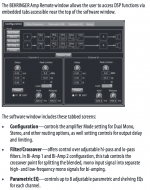
 Hid the gear in the bushes (and enjoyed the dbs from corner coupling)
Hid the gear in the bushes (and enjoyed the dbs from corner coupling)